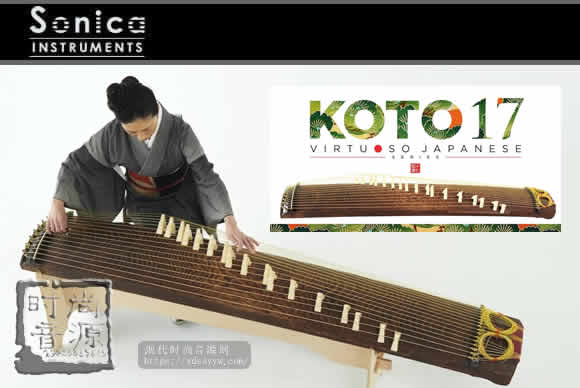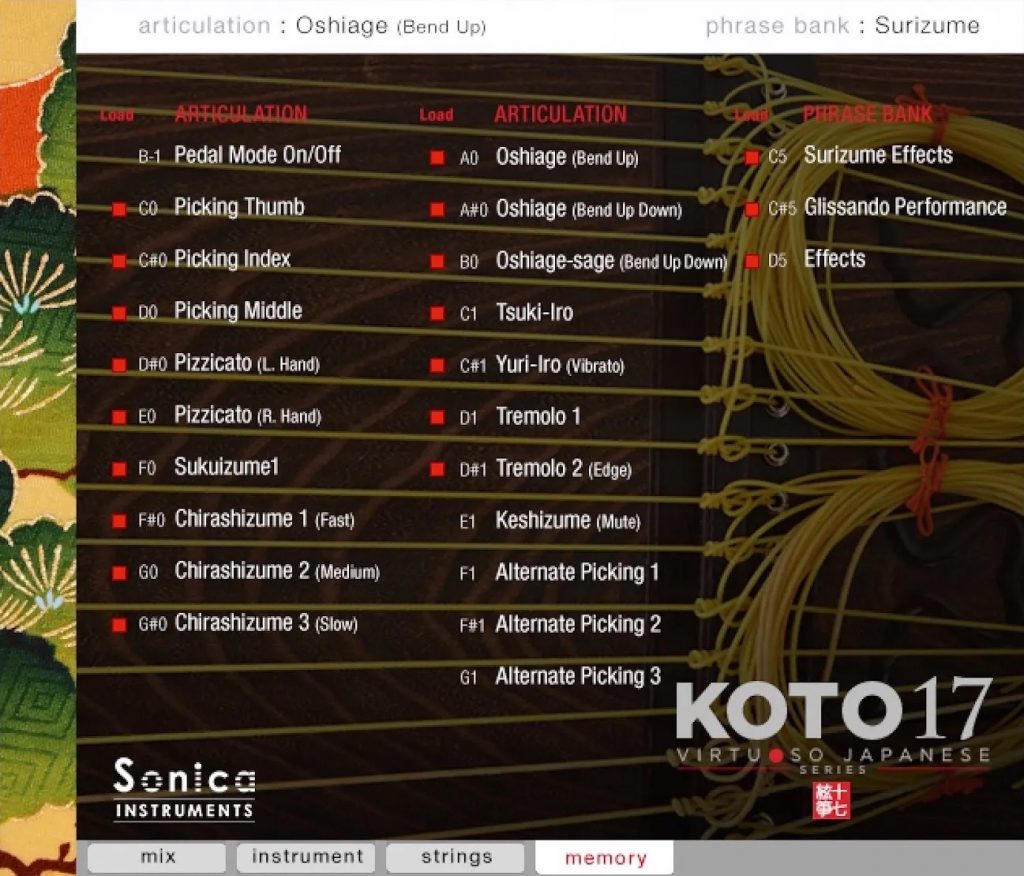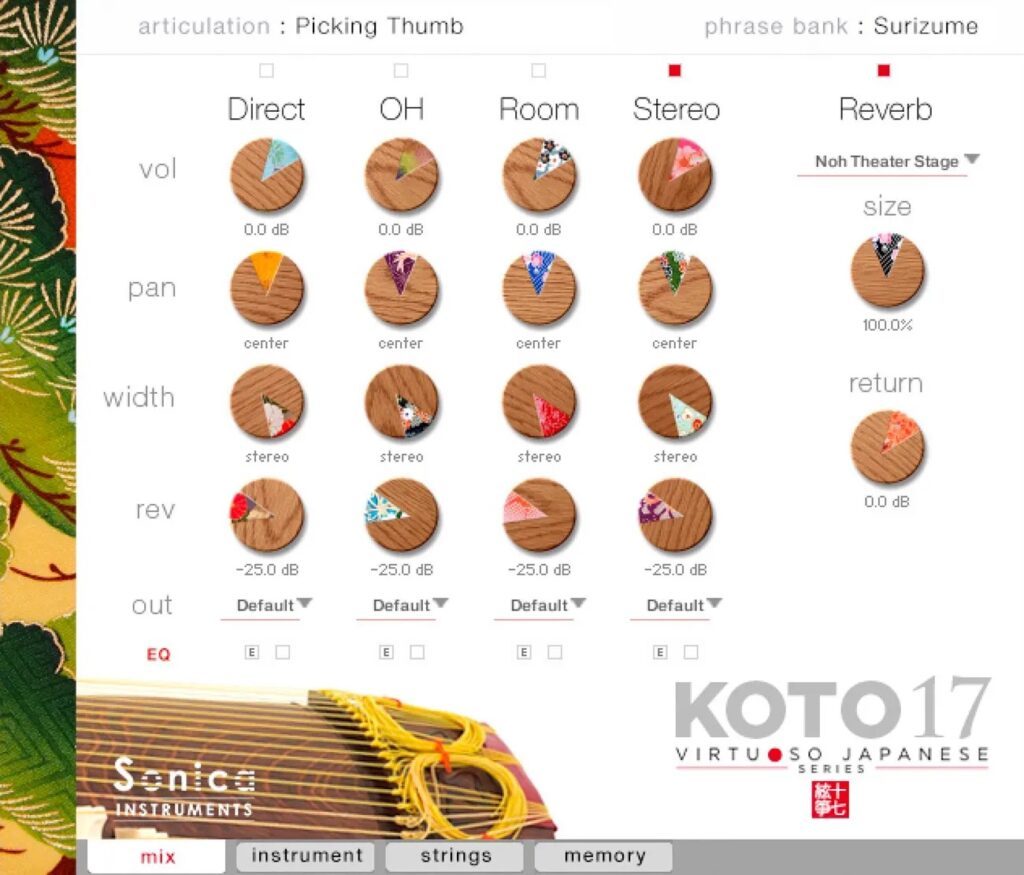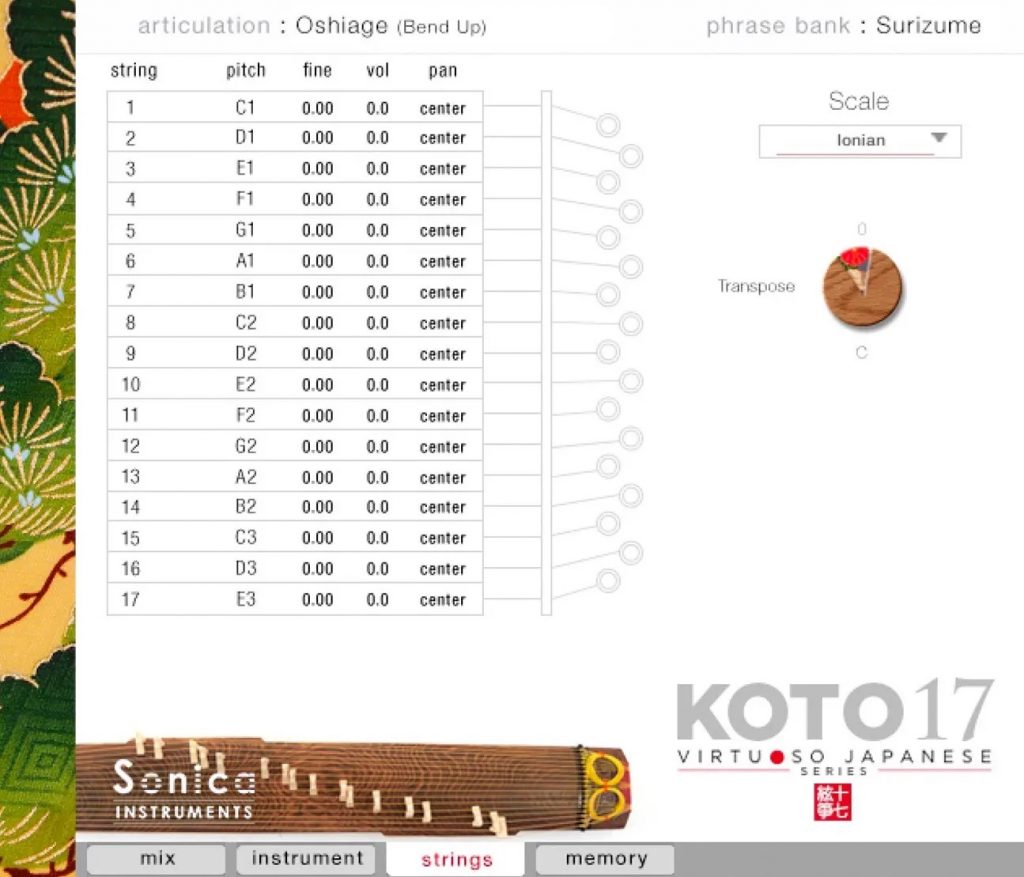
系统要求:PC/MAC
软件格式:KONTAKT
厂家:https://sonica.jp/instruments/en/product/koto17/
大小:13.95 GB
时间:2021年5月19日
KOTO 17 – 处女作日本系列
KOTO 17 是 Virtuoso 日本系列的第七个标题,它为世界各地的音乐创作者带来了 17 弦低音 Koto 的声音,这是现代日本音乐不可或缺的一部分。
KOTO 13 开发三年后,KOTO 17 受益于高级功能,这些功能从图书馆中调用了新的色调品质。
当然,KOTO 17可以用作独奏乐器。但它与13弦的科托和沙库哈奇相得益彰,使其成为古典音乐和当代日本音乐界不可或缺的组成部分。当与来自Virtuoso日本系列的其他头衔配对时,如KOTO 13、KOTO 20或沙库哈奇,KOTO 17可以完成一个令人难以置信的强大的合奏。

主要特点
由于细致的录制技术和创新编程,17 弦 Koto 的每一个性能细微差别的无与伦比再现
独家性能模式将 17 个字符串映射到相邻的白键上,便于执行真正的 koto glissandos 和短语
17 弦 Koto 的基本 20 个关键开关可选择铰接
维持踏板控制,用于自然连续采摘措辞
新开发的仪器建模器再现了由于不同的指尖和弦的声音变化
字符选择器允许您从三个指尖厚度中进行选择
字符串音选择器提供三种字符串音:厚、正常和薄
包括三个典型的科托短语银行, 所有钥匙开关可控
拔出控制功能,完全掌握微妙的,自然的声音挑选笔记
字符串编辑器启用所有 17 个字符串的独立调整调整
除了 10 个预设比例表外,用户比例模式还允许您创建原始比例表
所有样品均以24位/96 kHz的高分辨率记录,以捕捉每一个色调细节
使用多麦克风样品创建自己的混音器和专用混频器,并配有直接、开销、房间和立体声混合通道的单独控制
兼容孔塔克特播放器 / 孔塔克特全 Ver. 5.7.3 或更新
已准备好
17弦乐是现代日本音乐不可或缺的一部分,从未像现在这样现实。
字符串编辑器启用所有 17 个字符串的独立调整调整

Koto 是通过调整每首音乐作品的 17 个弦的调谐来演奏的。KOTO 17 具有比例执行模式,可将每个字符串的音调映射到 17 个相邻的白键。这允许表演者以最现实的方式访问乐器。
20 个铰接,以重现 17 弦科托演奏风格的各个方面
KOTO 17 包含 20 种不同的表达方式,以重现 Koto 的各种音乐表达方式。这些包括通过玩拇指、食指或中指以及格利桑多斯、特雷莫洛采摘,甚至辣椒采摘刮伤而产生的不同细微差别。所有铰接都可以通过钥匙开关独立控制。
三个KOTO 17短语银行包含特殊的技术,很难复制,从经典的科托技术,如格利桑多斯和苏里祖姆,以击中桥梁的声音效果。短语库可选择键开关,可从 MIDI 键盘触发。您也可以控制每个短语库的音高和节奏。
乐器建模器再现不同指尖和弦的声音变化
科托的色调特征因使用的指尖和字符串厚度而异。为了忠实地再现这些变体,我们开发了一种称为仪器建模器的新功能。
使用仪器建模器,您可以调整单个参数,包括指尖和字符串厚度(厚、常、薄)、音符瞬态的间距和攻击以及噪声组件。此功能使得以任何您喜欢的方式控制声音的字符成为可能,从自然的演奏感觉到非常积极的表演。
交替采摘铰接和维持踏板控制,用于自然连续采摘措辞
库配有三个备用的拾取铰接,以重现在播放一系列拾取笔触时发生的自然声音变化。可使用钥匙开关或持续踏板控制切换替代采摘。此功能使复制逼真的树皮采摘变得容易。

打开持续踏板控制后,您可以在正常采摘和事件键之间切换,在关键关闭事件之间切换。
字符串编辑器启用所有 17 个字符串的独立调整调整
图书馆配备了10个常用的秤(铬,离子,自然小,谐波小,旋律小,多利安,佛瑞吉安,莱迪安,混合,全音),包括色度。您可以执行许多音乐作品与预设和关键转换功能。额外的用户比例模式允许您为特定构图创建自定义比例。创建自定义比例时,您可以为每个字符串设置音量和平移,并微调每个字符串。
•用户比例通过
自定义所有 17 个字符串,您可以为特定曲调或原始作品设置比例表,从而允许您将 Koto 元素融入任何音乐中。自定义天平可作为用户比例保存,可随时召回。
注意:无法转换用户比例。
多麦克风样品
全24位/96 kHz高分辨率
录音是极其小心地制作的,使用超过八个不同类型的麦克风以及无色麦克风预放大器。所有库样本均以 24 位 / 96 kHz 高清记录,以忠实地捕捉整个 Koto 的精致表情。
这些样本被记录在三个立体声麦克风位置-直接,头顶和房间-再加上立体声混合。提供完整的混合控制,每个通道可进行单个音量、泛、混响发送和EQ调整。并行输出总线将麦克风通道发送到各个 DAW 轨道,以便进行更精细的混合会话。
图书馆里有30个卷积混响,包括两个来自Noh剧院的冲动反应,该剧院以其声学而闻名于音乐家。卷积混响允许高质量的仪器内声音创作。
负载管理器可减少更平滑的生产工作的内存使用
使用负载管理器,执行者可以选择只加载所需的铰接。跳过不必要的样品可以从康塔克特发动机获得更平稳的性能。
已准备好
KOTO 17 兼容 NKS,因此可以与康塔克特播放器、孔塔克特满(Ver. 5.7.3 或较新)和康普莱特康特罗尔一起使用。
当 KOTO 17 与康普莱特 Kontrol 键盘或其他 NKS 兼容的硬件连接时,您可以快速预览音调,并充分利用硬件的旋钮和控制器。
系统要求
“数据大小”
14.97 GB NCW 格式(相当于 33.26 GB 的 wav 格式)
格式化]
本地仪器康塔克特 5.7.3 或较新
联系人兼容
已准备好
“要求”
Mac 操作系统 X 10.10 或更新
视窗 7、视窗 8 或视窗 10
英特尔核心 2 二重奏或 AMD 阿思隆 64 X2
Mac 和 Windows 系统都需要至少 4 GB 的 RAM(建议为 16 GB)。
演员
三木丸田
从日本古典音乐到当代作品,三木丸田精通一系列音乐类别,但始终追求高藤的自然嗓音。这种方法,加上她愿意的适应性和包容性的情感敏感性,有助于她与跨流派和跨界艺术家的成功合作。
在通过了要求苛刻的NHK日本音乐试演后,她于1990年至1992年在美国卫斯理大学任教,担任音乐客座讲师。1994年,Miki Maruta被选为文化事务局表演艺术实习员,2009年,她与特里·莱利和克罗诺斯四重奏在纽约卡内基音乐厅演出。
她已经发布了一张个人专辑托里没有 yo ni (像鸟) 在国王记录, 并出现在许多艺术家的 CD 版本。她甚至出现在阿亚塔卡绿茶的电视广告中。三木丸田已经出版了许多流行的安排,科托音乐播放的五音符规模。
丸田美智子在佐井大和佐井嘉子的带领下学习,以最高荣誉毕业于高崎音乐学院。她目前是佐井高藤学院的教授和米大学的兼职讲师
KOTO 17, the seventh title in the Virtuoso Japanese Series, brings the sounds of the 17-string bass koto, an indispensable part of modern Japanese music, to music creators everywhere.
Coming three years after the development of KOTO 13, KOTO 17 benefits from advanced features that coax new tonal qualities from the library.
Naturally, KOTO 17 can be used as a solo instrument. But it complements the 13-string koto and shakuhachi extraordinarily well, making it an essential component in both classical and contemporary Japanese music circles. And when paired with other titles from the Virtuoso Japanese Series, such as KOTO 13, KOTO 20, or Shakuhachi, KOTO 17 can complete an incredibly powerful ensemble.
Main Features
Peerless reproduction of every performance nuance from the 17-string koto thanks to meticulous recording techniques and innovative programming
Exclusive Performance mode maps the 17 strings to adjacent white keys for easy performance of real koto glissandos and phrases
20 key-switch-selectable articulations fundamental to the 17-string koto
Sustain pedal control for natural continuous-picking phrasing
Newly developed Instrument Modeler reproduces sound variations due to different fingerpicks and strings
Character selector lets you choose from three fingerpick thicknesses
String tone selector offers three string tones: Thick, Normal, and Thin
Includes three banks of quintessential koto phrases, all key-switch controllable
Plucking control function for full mastery over subtle, natural sounding picked notes
String editor enables independent tuning adjustments for all 17 strings
In addition to the 10 preset scales, the User Scale mode lets you create original scales
All samples recorded in 24-bit / 96 kHz high resolution to capture every tonal detail
Create your own mixes with the multi-microphone samples and a dedicated mixer with individual controls for Direct, Overhead, Room, and Stereo Mix channels
Compatible with Kontakt Player / Kontakt Full Ver. 5.7.3 or newer
NKS ready
17-string koto, an indispensable part of modern Japanese music, has never been more realistic.
String editor enables independent tuning adjustments for all 17 strings
The koto is played by adjusting the tuning of the 17 strings for each musical piece to be performed. KOTO 17 has a Scale Performance mode to map the tones of each string to 17 adjacent white keys. This lets the performer access the instrument in the most realistic way possible.
20 articulations to recreate every aspect of the 17-string koto’s playing styles
KOTO 17 contains 20 different articulations to recreate the koto’s diverse range of musical expressions. These include different nuances created by playing with the thumb, index, or middle finger as well as glissandos, tremolo picking, and even chirashizume pick scrapes. All articulations can be controlled independently with key switches.
The three KOTO 17 phrase banks contain special techniques that are difficult to reproduce, ranging from classic koto techniques such as glissandos and surizume to sound effects made by striking the bridges. Phrase banks are selectable with key switches and can be triggered from a MIDI keyboard. You can control the pitch and tempo of each phrase bank as well.
Instrument Modeler reproduces sound variations from different fingerpicks and strings
The tonal characteristics of the koto vary a lot depending on the fingerpick and string thickness used. To faithfully reproduce these variations, we developed a new function called the Instrument Modeler.
With the Instrument Modeler, you can adjust individual parameters, including the fingerpick and string thickness (Thick, Normal, and Thin), the pitch and attack of note transients, and noise components. This functionality makes it possible to control the character of the sound any way you like, from a natural playing feel to very aggressive performances.
Alternate picking articulations and sustain pedal control for natural continuous-picking phrasing
The library comes with three alternate picking articulations to recreate the natural sound variations that occur while playing a succession of pick strokes. Alternate picking can be switched with key switches or the sustain pedal control. This function makes it easy to reproduce realistic tremolo picking.
With the sustain pedal control on, you can switch between normal picking with key on events and alternate picking with key off events.
String editor enables independent tuning adjustments for all 17 strings
The library comes with 10 frequently used scales (Chromatic, Ionian, Natural Minor, Harmonic Minor, Melodic Minor, Dorian, Phrygian, Lydian, Mixolydian, Whole Tone), including a chromatic scale. You can perform many musical pieces with the presets and the key transposition function. The additional User Scale mode lets you create custom scales for specific compositions. When creating a custom scale, you can set the volume and panning for each string as well as fine tune each string.
○User scales
By customizing all 17 strings, you can set up scales for specific tunes or for your original compositions, allowing you to incorporate koto elements into any piece of music. Custom scales are saved as user scales and can be recalled at any time.
Note: User scales cannot be transposed.
Multi-microphone samples
in full 24-bit / 96 kHz high resolution
The recordings were made with the utmost care, using more than eight microphones of various types together with colorless mic preamps. All library samples were recorded in 24-bit / 96 kHz high definition to faithfully capture the entirety of the koto’s delicate expressions.
The samples were recorded with three stereo microphone positions — Direct, Overhead, and Room — plus a Stereo Mix. Full mixing control is available, with individual Volume, Pan, Reverb Send, and EQ adjustments for each channel. The parallel output bus sends the microphone channels to individual DAW tracks for finer mixing sessions.
The library comes with 30 convolution reverbs, including two impulse responses from a Noh theater renowned among musicians for its acoustics. The convolution reverbs permit high-quality in-instrument sound creation.
Load manager reduces memory usage for smoother production work
With the load manager, the performer can choose to load only the desired articulations. Skipping unnecessary samples obtains smoother performance from the Kontakt engine.
NKS ready
KOTO 17 is NKS compatible so it can be used with Kontakt Player, Kontakt Full (Ver. 5.7.3 or newer), and Komplete Kontrol.
When KOTO 17 is linked with a Komplete Kontrol keyboard or other NKS-compatible hardware, you can quickly preview tones and make full use of the hardware’s knobs and controllers.
System Requirements
【Data size】
14.97 GB NCW format (equivalent to 33.26 GB in wav format)
【Format】
Native Instruments Kontakt 5.7.3 or newer
Kontakt Player compatible
NKS ready
【Requirements】
Mac OS X 10.10 or newer
Windows 7, Windows 8, or Windows 10
Intel Core 2 Duo or AMD Athlon 64 X2
A minimum of 4 GB of RAM (16 GB is recommended) is needed on both Mac and Windows systems.
Performer
Miki Maruta
While proficient in an array of musical categories, from classical Japanese music to contemporary compositions, Miki Maruta has always pursued the koto’s natural voice. This approach, together with her willing adaptability and inclusive emotional sensitivity, has contributed to her success in collaborating with artists across genres and borders.
After passing the demanding NHK Japanese music audition, she went on to teach at Wesleyan University in the United States as a visiting instructor in music from 1990 to 1992. In 1994, Miki Maruta was selected for an internship in the performing arts at the Agency for Cultural Affairs and in 2009, she performed with Terry Riley and the Kronos Quartet at Carnegie Hall in New York.
She has released a solo album Tori no yo ni (Like a Bird) on King Records and been featured on numerous artists’ CD releases. She even appeared in a TV ad for Ayataka green tea. Miki Maruta has published many popular arrangements of koto music played on a five-note scale.
Miki Maruta studied under Tadao Sawai and Kazue Sawai and graduated from the Takasaki College of Music with top honors. She is currently a professor at Sawai Koto Academy and a part-time lecturer at Mie University.